Phylum Chordata Order Crocodiles | Class Reptilia Rank Genus | |
 | ||
Similar Agilodocodon, Aerodactylus, Anthracobunidae, Aquilonifer, Apidium | ||
Allodaposuchus is an extinct genus of crocodyliforms that includes four species that lived in what is now southern Europe during the Campanian and Maastrichtian stages of the Late Cretaceous. Although generally classified as a non-crocodylian crocodylomorph, it is sometimes placed as one of the earliest true crocodylians. Allodaposuchus is one of the most common Late Cretaceous crocodylomorphs from Europe, with fossils known from Spain, Romania, and France.
Contents
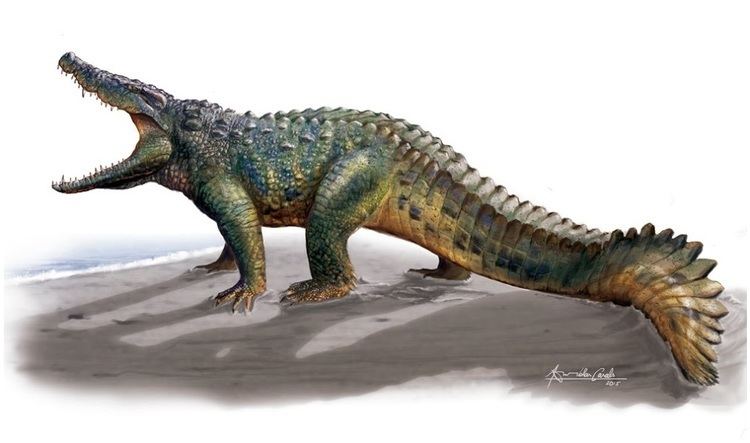
Description
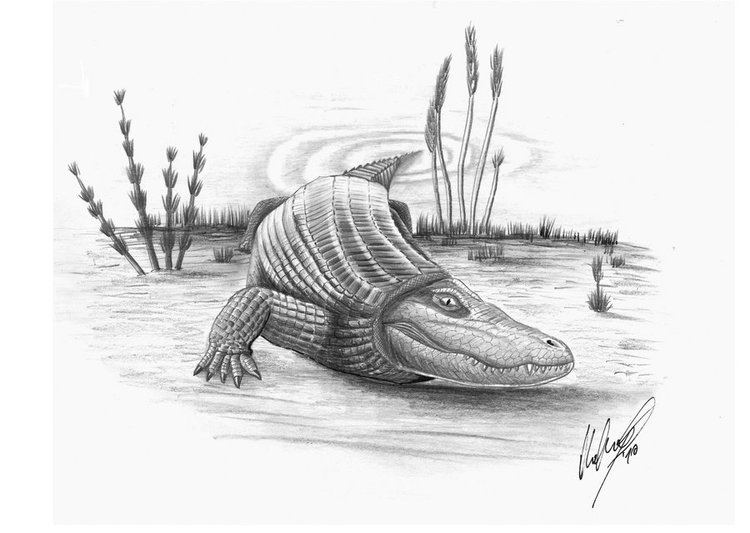
Like many other Cretaceous crocodylomorphs, Allodaposuchus has a relatively small body size compared to living crocodylians. The largest known specimen of Allodaposuchus belongs to an individual that was probably around 3 metres (9.8 ft) long. Although the shape varies between species, in general Allodaposuchus has a short, flattened, and rounded skull. Allodaposuchus precedens has a brevirostrine or "short-snouted" skull with a snout about the same length as the skull table (the region of the skull behind the eye sockets) and A. subjuniperus has a mesorostrine or "middle-snouted" skull with a snout that is longer than the skull table. The main feature that distinguishes Allodaposuchus species from other related crocodylomorphs is the orientation of a groove at the back of the skull called the cranioquadrate passage; unlike the cranioquadrate passages of other crocodylomorphs, which are only visible at the back of the skull, the cranioquadrate passage of Allodaposuchus is visible when the skull is viewed from the side.
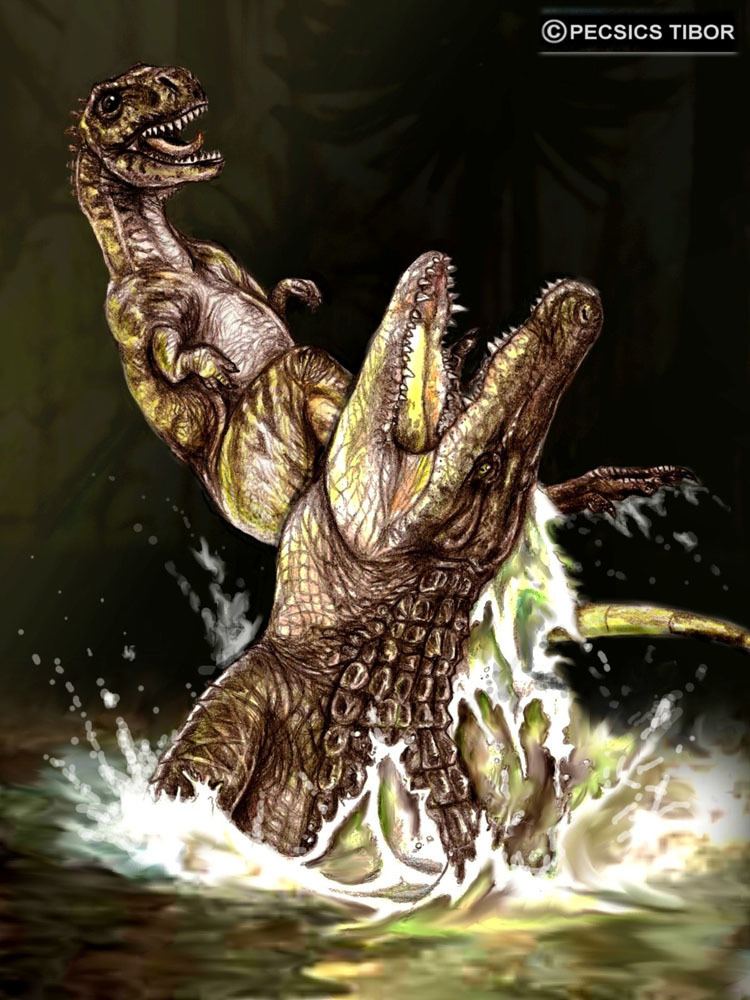
At least one species of Allodaposuchus, A. hulki, may have adaptations that would have allowed it to live on land for extended periods of time. A. hulki has large sinuses in its skull that are not seen in any other crocodylian living or extinct and may have aided it in hearing out of water, as well as lightening the skull. Moreover, A. hulki has well-developed muscle attachments on its scapula, humerus, and ulna bones that would have allowed the forelimbs to have been held in a semi-erect stance suitable for walking over land. Remains of A. hulki come from interbedded sandstones and marls that, based on the presence of charophyte algae, likely formed in ephemeral ponds in a large floodplain far from permanent bodies of water like lakes or rivers. A. hulki may therefore have spent much of its time out of water, travelling between these ponds for food.
History of study

There are four described species Allodaposuchus. The type species of Allodaposuchus, A. precedens, was named by Hungarian paleontologist Franz Nopcsa in 1928 from Vălioara, Romania. Nopcsa found bone fragments in a deposit of the Hațeg Basin that dates back to the late Maastrichtian stage – the very end of the Late Cretaceous. Several partial skulls from Spain and France were attributed to A. precedens in 2001. Some of these skulls came from Campanian-age deposits slightly older than those in Romania, meaning that the species must have persisted for about 5 million years. In 2013 a second species of Allodaposuchus, A. subjuniperus, was named on the basis of a skull from the late-Maastrichtian Conqués Formation in the province of Huesca, Spain. The skull was found underneath a juniper tree whose roots had grown between the bones, hence the species name subjuniperus or "under juniper" in Latin. The 2013 study also proposed that the French and Spanish fossils assigned to A. precedens in 2001 might actually represent a new unnamed species of Allodaposuchus currently identified as Allodaposuchus sp. A study published in 2005 had suggested that these fossils belong to several different genera of crocodylomorphs and that the original Romanian material is too fragmentary to assign to its own genus, making Allodaposuchus a nomen dubium or "dubious name". However, the 2013 study reaffirmed the Romanian material's distinctiveness from other European Cretaceous crocodylomorphs and therefore reaffirmed the validity of Allodaposuchus as a genus.
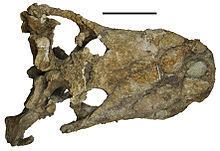
In 2014, A. palustris was described from a partial skull and other skeletal fragments found in Maastrichtian age sediments of the Tremp Formation in a fossil locality called Fumanya Sud in the southern Pyrenees. These remains allowed for the first detailed description of the postcranial (non-skull) anatomy of Allodaposuchus. A fourth species of Allodaposuchus, A. hulki, was named in 2015 and also came from the Tremp Formation, although this time in a locality called Casa Fabà. The species is named after the Hulk from Marvel Comics, in reference to features on the bones that suggest it had strong muscles.
Relationships
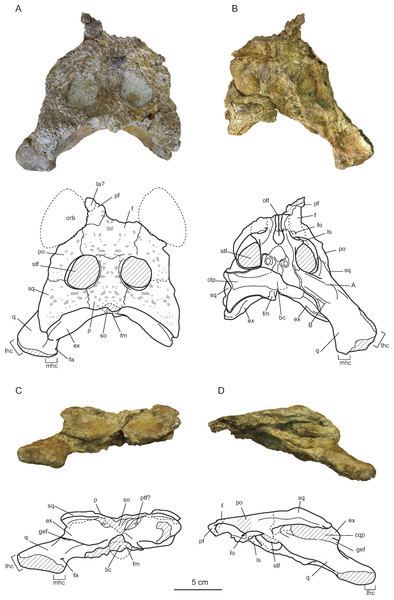
Allodaposuchus is one of the earliest members of the Crocodylia clade, the most exclusive group including all modern crocodylians. The ancestors of Allodaposuchus and other crocodylians were part of a larger evolutionary group called Eusuchia that originated in the Early Cretaceous. Allodaposuchus is part of an evolutionary radiation of eusuchians that happened later in the Cretaceous as they spread to multiple continents.
When Franz Nopcsa named Allodaposuchus, he proposed that it was a close relative of Leidyosuchus, a crocodylian from Canada. However, Nopsca could only base this assignment on a few fragments of bone. After more complete material was uncovered from Spain and France, Allodaposuchus was reinterpreted as a non-crocodylian eusuchian in 2001. The 2001 study recognized a close relationship between Allodaposuchus and Hylaeochampsa, a eusuchian from the Early Cretaceous of England. A 2010 phylogenetic analysis supported a relationship similar to Nopsca's by placing Allodaposuchus within Alligatoroidea, a group of crocodylians that includes modern-day alligators and Leidyosuchus. The most recent phylogenetic analyses of Allodaposuchus – published alongside the descriptions of A. palustris in 2014 and A. hulki in 2015 – place it within Crocodylia but outside Alligatoroidea as a sister taxon (closest relative) of the clade Brevirostres, which includes Alligatoroidea and Crocodyloidea, the group including crocodiles and their closest extinct relatives. According to these studies Allodaposuchus is more closely related to Alligatoroidea and Crocodyloidea than it is to the third major group of living crocodylians, Gavialoidea, which includes modern gharials. Among extinct groups, Allodaposuchus is most closely related to the genus Borealosuchus, which existed in North America from the Late Cretaceous to the Eocene, and the family Planocraniidae, which existed in North America, Europe, and Asia from the Paleocene to the Eocene.
The 2015 analysis also indicated a close relationship between Allodaposuchus species and a genus called Arenysuchus, regarded as a crocodyloid in earlier analyses. Like Al. palustris and Al. hulki, Arenysuchus comes from the Tremp Formation of Spain, although from a different locality called Elías. Arenysuchus fell within the Allodaposuchus clade, being more closely related to A. hulki and A. precedens than is A. palustris, raising the possibility that Allodaposuchus is a polyphyletic taxon (i.e., not a true clade) . The authors of the analysis proposed the name Allodaposuchia for the clade containing Arenysuchus and Allodaposuchus species. Below is a cladogram from that analysis:
